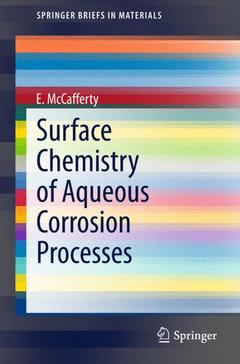Surface Chemistry of Aqueous Corrosion Processes, 2015 SpringerBriefs in Materials Series
Auteur : McCafferty E.

Dr. Edward McCafferty, formerly of the Naval Research Laboratory, is currently a consultant in Alexandria, VA. He has published extensively in the fields of corrosion science and surface chemistry. Dr. McCafferty's interests include corrosion and corrosion protection, localized corrosion, corrosion inhibition, models of passivity and its breakdown, oxide surfaces, surface modification techniques such as ion implantation and laser-surface processing, and the adhesion of organic polymers. Dr. McCafferty is a Fellow of the Electrochemical Society and is the 2007 recipient of the H. H. Uhlig Award of the Electrochemical Society for excellence in corrosion research. Dr. McCafferty is also Past Chairman of the Corrosion Division of the Electrochemical Society. He has received the Jerome Kruger Award in Corrosion Science, Baltimore-Washington Chapter of NACE (2003) and the Victor K. LaMer Award of the American Chemical Society (1971). Dr. McCafferty holds a B.S. in Chemistry from Wilkes College, an M.S. and Ph.D in Chemistry from Lehigh University, and an M.S. in Applied Mathematics from Johns Hopkins University. He has been a Visiting Scientist, Department of Chemistry and the Center for Adhesive and Sealant Science, Virginia Tech University (1996-1997) and a Robert A. Welch Postdoctoral Fellow at the University of Texas with Prof. Norman Hackerman (1968-1970). He has also had industrial experience as a Research Engineer at the Bethlehem Steel Corporation (1955-1959).
Connects Surface Science and Corrosion
Covers the relationship between capillary phenomena and corrosion
Written by a leading expert on Corrosion
Includes supplementary material: sn.pub/extras
Date de parution : 03-2015
Ouvrage de 89 p.
15.5x23.5 cm
Disponible chez l'éditeur (délai d'approvisionnement : 15 jours).
Prix indicatif 52,74 €
Ajouter au panier


